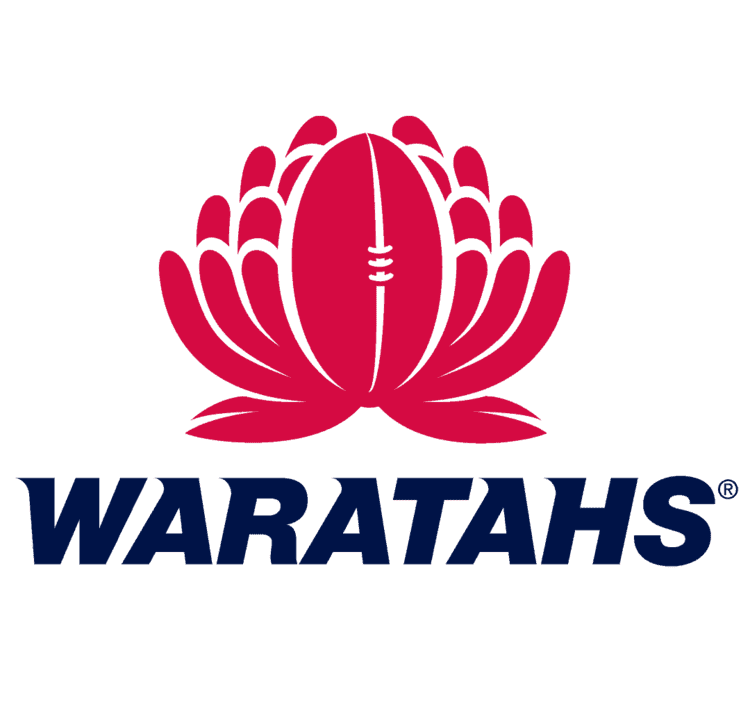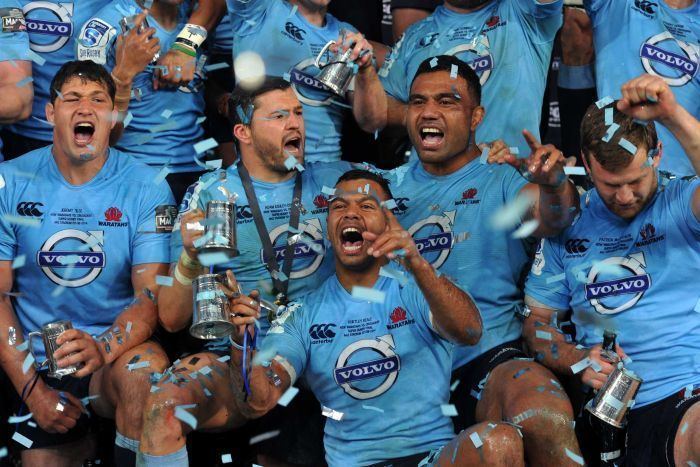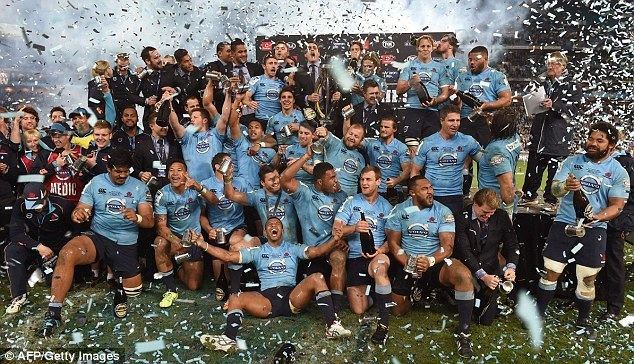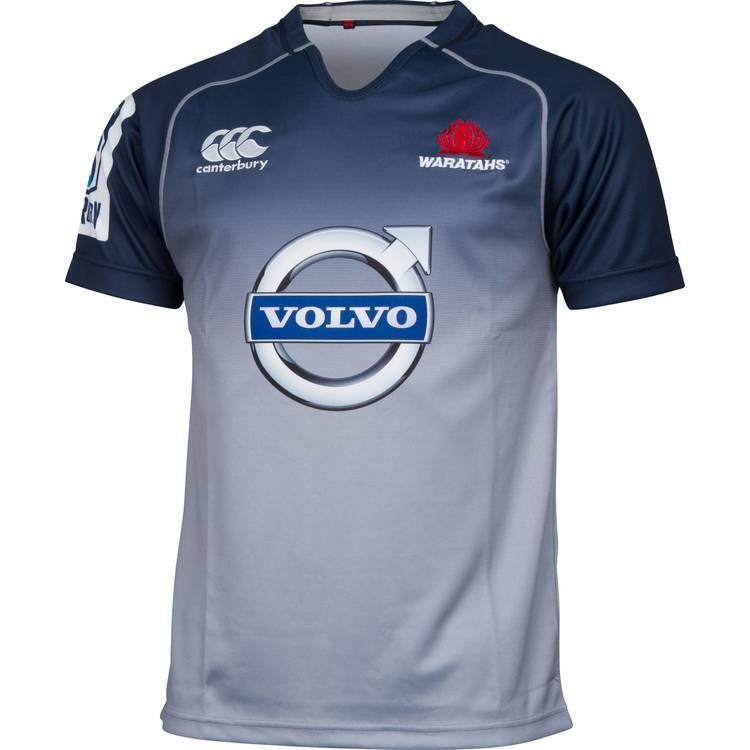Nickname(s) Tahs CEO Andrew Hore (9 Mar 2016–) | Union Australian Rugby Union | |
 | ||
Founded 1882 (first NSW match)1996 (first Super 12 match) Ground(s) Allianz Stadium (capacity: 45,500)ANZ Stadium (capacity: 83,500) Profiles | ||
The New South Wales Waratahs (/ˈwɒrətɑːz/ or /ˌwɒrəˈtɑːz/; referred to as the Waratahs, are an Australian rugby union team representing the majority of New South Wales in the Super Rugby competition. The Riverina and other southern parts of the state, are represented by the Brumbies, who are based in Canberra, Australian Capital Territory (ACT).
Contents
- Amateur era
- Super 12 19962005
- Super 14 20062010
- Super Rugby 2011present
- Championship season 2014
- Logo and colours
- Stadium
- Team song
- Development teams
- Gen Blue NSW A
- NSW Under 20
- Current squad
- Waratahs player award winners
- Coaches
- Professional era
- Statistics
- Team
- Individual
- References

The "Waratahs" name has historically been the name for the New South Wales Rugby Union (NSWRU) representative team, and became the name for the New South Wales team when it entered the Super Six, Super 10 and Super 12 competitions. The name and emblem comes from the waratah, the state flower for New South Wales. Their home ground is Allianz Stadium in Sydney. Some matches are also held at ANZ Stadium.

Amateur era

The NSWRU (or then, The Southern RU – SRU) was established in 1874, and the very first club competition took place that year. By 1880 the SRU had over 100 clubs in its governance in the metropolitan area. In 1882 the first New South Wales team was selected to play Queensland in a two-match series. NSW would go on to win both the games. That same year the first NSW touring squad was selected to go and play in New Zealand.

In 1907, several of the New South Wales rugby union team's players defected to play for the New South Wales rugby league team against a visiting rebel New Zealand rugby team. This was essentially the birth of rugby league in Australia.
During World War I, the NSW (and QLD) Rugby Unions ceased senior competition. The Queensland body however would not reform until 1929, which saw NSW have more responsibilities for Australian rugby. In 1921 the Waratahs toured New Zealand again, and out of their 10 fixtures, won nine games, including the Test.

The most famous Waratah team was the 1927/28 Waratahs who toured the United Kingdom, France and North America, introducing a style of open, running rugby never seen before, but which has been the stamp of the Australian game ever since. They won 24 and drew two of their 31 official matches. Seven members of this 1927/8 side were from the Drummoyne Rugby Club. Upon returning home, were greeted with a parade through Sydney and a reception at Town Hall. Matches against Queensland would soon resume also.
The 1930s were a particularly successful time for NSW. The height of the success of NSW is best represented by the defeat of the South African Springboks in 1937 at the SCG. NSW Rugby Union would also perform strongly throughout the following decades as well, which included the emergence of footballers such as Trevor Allan, David Brockhoff, Tony Miller, Nick Shehadie, Eddie Stapleton, Ken Catchpole, John Thornett, Peter Crittle and Ron Graham.
In 1963 the Sydney Rugby Union was established for the growth of the game in the city area. The NSW Rugby Union would celebrate its 100th anniversary in 1974. As part of the anniversary celebrations, a match was played at the SCG on 18 May against the All Blacks, though the Waratahs lost nil to 20.
Super 12: 1996–2005
In their inaugural Super 12 season of 1996, the Waratahs won just under half of their games, finishing mid table, with the two other Australian teams finishing above them. The following season of 1997 saw the Waratahs end in a 9th place, winning four fixtures.
In the 1998 season the Waratahs won a best six out of 11 games, ending up in 6th position on the ladder at the end of the season, despite obvious improvements the team had still yet to make a finals appearance. The Waratahs won four fixtures the next season. They won five games in the 2000 season and the 'Tahs finished their season in 9th place.
In 2001 after replicating their 2000 performance, the Waratahs were still out of reach of finals contention, in 8th position. 2002 was a record breaking season for the Waratahs, as the team won eight out of their 11 season games and finished in second place behind the Crusaders – making the semis. However, in the final game of the regular season the Waratahs lost 96–19 (a Super Rugby record). They were defeated by their Australian rivals the Brumbies, 51–10, in the Waratahs' first ever semi-final. The combined score over the two weeks was Brumbies/Crusaders 147 v. Waratahs 29.
In the 2003 season the Waratahs missed a place in the finals, finishing in 6th position on the ladder at the end of the regular season. In 2004 the Waratahs made a promising start to their season with three straight wins. The team finished 8th on the Super 12 table, six points out of the finals. That year coach Ewen McKenzie re-introduced the end of season tour, taking place in Argentina that year. In 2005, they had their best regular season, finishing second in the table, before losing to the Crusaders in the 2005 Super 12 Final.
Super 14: 2006–2010
The Waratahs finished 3rd on the regular season table for the 2006 Super 14 season, in which two new teams entered the expanding tournament, the Force and Central Cheetahs. In the last home match of the regular season, the Waratahs hosted the Hurricanes, which they lost 14 to 29. The news that star league recruit Wendell Sailor had tested positive to an illegal substance and thus faced a career ending ban from the game was an unwelcome intrusion on the Waratahs semifinal build up. The following week, the semi-finals, they again faced the Hurricanes, though away in Wellington. The Waratahs made their exit, losing 16 to 14. Wendell Sailor later received a two-year ban from the game, marring a season that had promised so much.
The 2007 Super 14 season was the most disappointing for the team and its supporters with the Waratahs winning only three games against the lions, the wooden spoon winning Reds, and the Hurricanes in the final round gaining a final placing of 13th out of 14. Despite the poor performance the 2007 season saw the emergence of teenage rugby prodigy Kurtley Beale and proved to be a vital rebuilding stage in the Waratahs super 14 championship run.
The 2008 season began well for the NSW Waratahs, with solid pre-season wins and a solid opening game victory against the Hurricanes 20–3. The 'Tahs secured their 500th win since their formation in their Fourth Round match against the Brumbies. After starting the season in a slow but solid manner the 'Tahs began to play their best rugby in their mid season match with the blues scoring their first four try bonus point of the season. The Waratahs then continued on a roll finishing their home season with another impressive 4 try bonus point win against title front runners the Sharks, advancing to second place on the ladder. An average South African trip saw the team slip to third on the ladder after only notching up 3 competition points, due to a loss to the Bulls (7 or less BP) and a satisfactory draw against other title contenders the Stormers. The Waratahs faced the Reds in the final round with a win securing second place, combined with a home semi-final win over the Sharks, moved them up to their first Super 14 final against the Crusaders, which they later lost 12–20.
In the last two seasons of the Super14 format, the Waratahs failed to make the final on both occasions after narrowly missing the finals (on points difference) in 2009 and qualifying for the semi-final in 2010. They finished 5th and 3rd in respective years, losing to the Stormers in the semi-final of the 2010 season.
Super Rugby: 2011–present
In the 2011 season, the Waratahs again failed to reach the final. On this occasion, their season ended when they were eliminated by the Blues in the qualifying final after finishing 5th in the overall standings in the revamped competition. The following two seasons were very bleak by comparison. Coach Chris Hickey parted ways with the club at the end of the season with Michael Foley taking over the reigns for 2012. The Waratahs finished well outside finals contention in 2012 in 11th place. This brought about another change in the coaching department with Michael Cheika for 2013. His impact was not immediate as the Waratahs failed to make the finals for a second consecutive season finishing 9th overall.
Championship season 2014
The 2014 season of the super rugby competition was undoubtedly the Waratahs greatest season so far. The Waratahs not only overcame the Curse of the Tahs, a commonly held superstition, but they were also able to post the greatest super rugby season yet. The second season under coach Michael Cheika saw a new expansive style of rugby implemented which gave birth to exciting running rugby, bringing dwindling crowds back in force with home games averaging at around 19,152 people in attendance .
The running intent of Michael Cheika was quickly revealed after the team saw two fly halves announced in the starting game against Western Force. The Waratahs opening match not only saw Kurtley Beale’s return, scoring one try and having a hand in several others, but it was also a showcase to reveal the Tahs new weapon; Israel Folau. Israel highlighted Michael’s intent scoring a hat-trick of tries in what was soon to be a season of all-out attack by the Waratahs. Not only did the Waratahs score the most points in the opening match out of any team with a 43-21 score, but they also had the second largest winning margin of 22 points.
The Waratahs went on to win the Australian conference with 13 more points than the team that came in at second place, the Brumbies, and came in as the number one team 7 points ahead of the competition. The Waratahs were in the driver’s seat advancing straight through to the semi-finals; the club's 8th semi-final appearance. After the Brumbies defeated the Chiefs 32-30, the Brumbies advanced to compete against the Waratahs. The Waratahs displayed a show of force in their performance against an in-form Brumbies team, decimating them 26-8 granting the Waratahs a home final. The final, held at ANZ stadium, was host to 61,823 spectators who bore witness to one of the greatest spectacles of sport. With two tries a piece, six penalties each, and the Crusaders up 32-30, only one conversion made the difference. The turning point in the game was a penalty at the 79th minute by the famous New Zealand flanker, Richie McCaw 45 meters out. Bernard Foley’s penalty 45m out right in front of the post gave the Waratahs’ a lead 33-32. Maintaining possession till the siren sounded and the ball is placed out of bounds. The Waratahs had finally won a Super Rugby Championship.
Logo and colours
The New South Wales Waratahs commonly play in a Cambridge Blue jersey and navy blue shorts, blue having a long sporting association with the state and a famous rivalry with the red/maroon colour of Queensland. Longtime sponsors HSBC feature on the front of the jersey. The Waratahs wore the HSBC logo for the final time when they played Argentina in August 2013. The commencement of the 2014 season saw Volvo as the waratahs new major sponsor, after a number of years being minor sponsors with 'sleeve presence' on the previous jersey. An alternative white strip is also used. In pre-season of 2006, the Waratahs donned a New Jersey scheme in a trial game against the Crusaders. This system saw traditional rugby playing numbers on the back of jerseys replaced with the initials of the player. The current jersey is made by Canterbury of New Zealand (with the manufacturer's logo covered until 2010) and is Cambridge blue, with the alternate strip being white with navy piping.
Until 1885, New South Wales wore 'heather green' strips. From 1891 to 1897, New South Wales played in scarlet jerseys. The following season, the team adopted Cambridge blue jerseys. The light blue jersey and navy blue pants were established in 1897 and have been in effect ever since. The New South Wales rugby union team have historically been known to represent, the state flower, the Waratah.
Stadium
The Waratahs play at Sydney Football Stadium, which is in Sydney's Moore Park, adjacent to the Sydney Cricket Ground. The capacity for the stadium is 45,500. The Waratahs share the ground with Sydney FC and the Sydney Roosters.
In 2009, the Waratahs signed a multimillion-dollar deal with ANZ Stadium which will see them play at least one game per season at the Sydney Olympic Park stadium until 2015. All Waratah home finals matches are also played at the 84,000 capacity stadium.
As well as Sydney Football Stadium, the Waratahs have on occasion played fixtures at other stadiums throughout the state. During the Australian Provincial Championship, in which the Waratahs had two fixtures, the games were taken to the Central Coast Stadium in Gosford, and the other to Bathurst. The Waratahs also played trial matches at Campbelltown Stadium in 2008 and 2015.
Team song
At the end of every winning game, the Waratahs sing the following song:
Development teams
New South Wales rugby's two elite development squads just below full-time professional level are the Gen Blue (NSW A) and Under 20 teams. These teams are closely aligned with the Waratahs and are based at Moore Park, the training venue used by the Waratahs. Although not owned or managed by the Waratahs, the New South Wales National Rugby Championship teams also contract many of the players in these development squads. – See: Rams, Rays and Eagles
Gen Blue (NSW A)
The Gen Blue team plays matches against interstate and international representative teams, and has also competed in tournaments such as the Pacific Rugby Cup. Known by various names over the years including NSW A, Waratahs A, Gen Blue, and Junior Waratahs, the team is selected from the best emerging rugby talent in New South Wales. The squad is composed of Waratahs contracted players, extended training squad members, New South Wales Under 20s, and selected Shute Shield club players.
NSW Under 20
The New South Wales Under 20 team competes in the Australian Under 20 Rugby Championship and also plays occasional matches against other representative sides such as Pacific Rugby Cup teams. Prior to 2008, state colts teams at under 21 and under 19 age levels were fielded in national competitions and in the Trans-Tasman Trophy, but these teams have since been consolidated as under 20s.
Note: Byes (worth 4 points) were added to the competition between 2011 and 2013
Current squad
The squad for the 2017 season:
Waratahs player award winners
The Matthew Burke Cup is awarded to the best Waratahs player at the end of each season:
Coaches
All head coaches of the NSW Waratahs in the professional Super Rugby era, listed by order of the first game in charge of the team are:
Notes:
Professional era
Statistics
Statistics in this section include only those pertaining to Super Rugby matches (1996–present). They do not include any matches prior to this period (1882–1995). Records for "in a season" include finals games unless otherwise stated.
Correct as of 26 November 2014.
